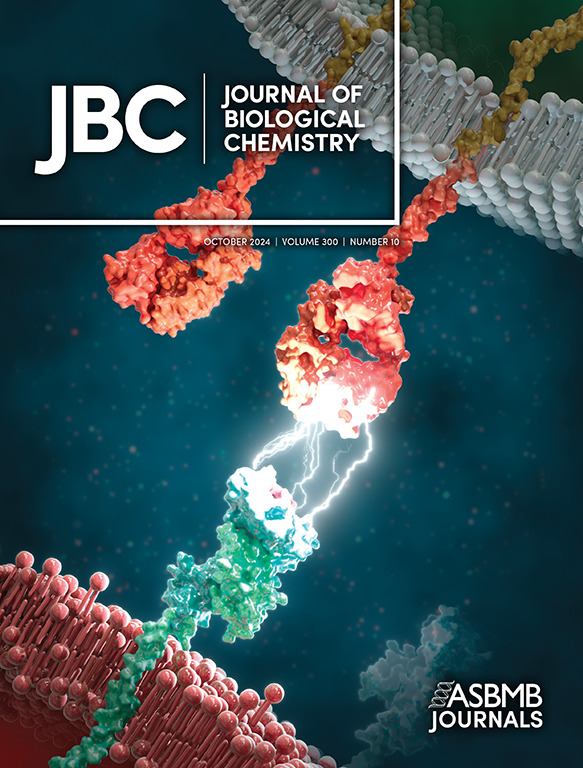How short is too short for amyloid fibrils?: molecular dynamics of oligomers of infectious prion core structures.
IF 4
2区 生物学
Q2 BIOCHEMISTRY & MOLECULAR BIOLOGY
引用次数: 0
Abstract
In many proteinopathies, the relative conformations of amyloid fibrils versus smaller oligomers remain unclear. Most tissue-derived isolates of infectious prion protein (PrP) prions are predominantly fibrillar. A few studies have asserted that prion amyloid fibrils efficiently disassemble into dimeric to tetrameric "elemental bricks" under certain detergent or chaotropic conditions, but our companion paper provides strong evidence to the contrary. Given our difficulties in isolating detectable amounts of small oligomeric (2-4-mer) prions, we performed molecular dynamics simulations to test the abilities of small fragments (dimers to 25-mers) of cryo-EM-based infectious prion fibril core structures to retain their conformational integrity. We show that dimers of the aRML prion structure lost most of their original secondary and tertiary structure within <<1 μs, while trimers maintained some intermolecular β-sheets. Further increases in fragment size helped preserve major structural motifs and the integrity of the templating surfaces responsible for self-propagation. In simulations of octamers and/or 25-mers, even at elevated temperatures, no fragmentation was observed for either the aRML, 22L, or 263K prion strains, although the terminal chains were substantially destabilized. Together, our results provide evidence that oligomeric fragments of prion fibril cores as small as tetramers retain substantial structural integrity. Our findings suggest that, as exemplified by PrP fibrils, short cores as small as tetramers may be stable enough to account for bioactive oligomeric species detected in brain extracts from proteinopathy patients. However, the lack of observed spontaneous core fragmentation suggests that prion oligomers might be rare in vivo and/or producedby non-autonomous physiological cleavage processes.淀粉样蛋白原纤维有多短才算太短?感染性朊病毒核心结构低聚物的分子动力学。
在许多蛋白质病变中,淀粉样蛋白原纤维与较小的低聚物的相对构象仍然不清楚。大多数感染性朊病毒蛋白(PrP)朊病毒的组织来源分离物主要是纤维状的。一些研究声称,朊病毒淀粉样蛋白原纤维在某些洗涤剂或混沌条件下有效地分解成二聚体到四聚体的“元素砖”,但我们的论文提供了强有力的证据。考虑到我们在分离可检测的小寡聚(2-4-mer)朊病毒方面的困难,我们进行了分子动力学模拟,以测试基于冷冻电镜的感染性朊病毒纤维核心结构的小片段(二聚体至25-mer)保持其构象完整性的能力。结果表明,aRML朊病毒结构的二聚体在<<1 μs内失去了大部分原有的二级和三级结构,而三聚体则保留了一些分子间的β-片。碎片尺寸的进一步增加有助于保存主要的结构基序和负责自我传播的模板表面的完整性。在八聚体和/或25-mers的模拟中,即使在高温下,也没有观察到aRML, 22L或263K朊病毒株的断裂,尽管末端链基本上不稳定。总之,我们的研究结果提供了证据,证明小到四聚体的朊病毒原纤维核心的寡聚片段保留了大量的结构完整性。我们的研究结果表明,如PrP原纤维所示,像四聚体一样小的短核可能足够稳定,可以解释在蛋白病患者的脑提取物中检测到的生物活性低聚物物种。然而,缺乏观察到的自发核心断裂表明,朊病毒低聚物可能在体内很罕见和/或由非自主的生理切割过程产生。
本文章由计算机程序翻译,如有差异,请以英文原文为准。
求助全文
约1分钟内获得全文
求助全文
来源期刊

Journal of Biological Chemistry
Biochemistry, Genetics and Molecular Biology-Biochemistry
自引率
4.20%
发文量
1233
期刊介绍:
The Journal of Biological Chemistry welcomes high-quality science that seeks to elucidate the molecular and cellular basis of biological processes. Papers published in JBC can therefore fall under the umbrellas of not only biological chemistry, chemical biology, or biochemistry, but also allied disciplines such as biophysics, systems biology, RNA biology, immunology, microbiology, neurobiology, epigenetics, computational biology, ’omics, and many more. The outcome of our focus on papers that contribute novel and important mechanistic insights, rather than on a particular topic area, is that JBC is truly a melting pot for scientists across disciplines. In addition, JBC welcomes papers that describe methods that will help scientists push their biochemical inquiries forward and resources that will be of use to the research community.
 求助内容:
求助内容: 应助结果提醒方式:
应助结果提醒方式:


